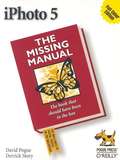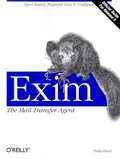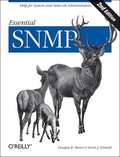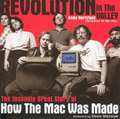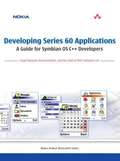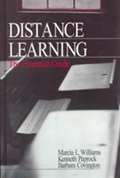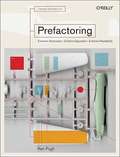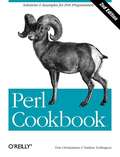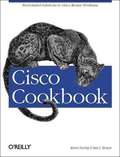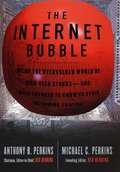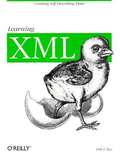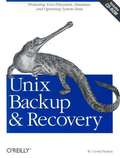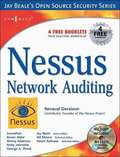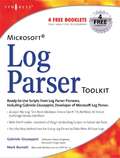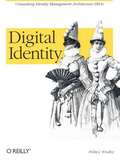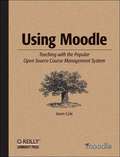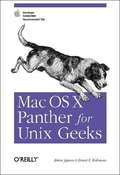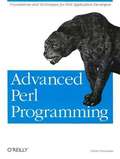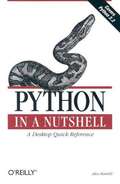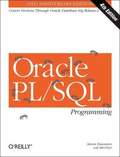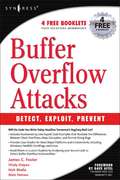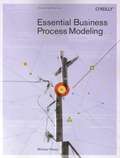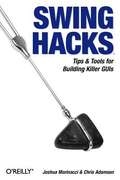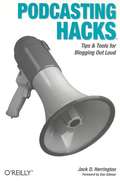- Table View
- List View
iPhoto 5: The Missing Manual, 4th Edition
by David Pogue Derrick StoryOur Missing Manual is hands-down the bestselling book on iPhoto. And now, updated to cover Apple's newest release, iPhoto 5: The Missing Manual comes fully loaded--and in full color--so you can exercise all the power, flexibility, and creativity of the stunning new iPhoto 5. Some of iPhoto 5's fifty new features are tiny nips and tucks, such as menu rewordings, quiet refinements, and secret keystrokes that take most people days to stumble through. Others are big-ticket overhauls aimed at both power users (RAW-file import and editing, color correction sliders, real-time histogram) and everyday shutterbugs (nested file folders, individual-photo control in slideshows, and a completely rewritten book-layout kit). Additional improvements include a robust search feature (similar to that of iTunes) and the addition of "objects" for slideshow and book projects (using objects, you can manipulate images without affecting pictures in your master library). iPhoto 5: The Missing Manual covers them all with the scrupulous objectivity, clever wit, and technical wisdom you count on from David Pogue along with the Mac and digital photography expertise of Derrick Story. Their authoritative guide starts out with a crash course on digital photography, complete with tutorials on buying a digital camera, composing brilliant photos in various situations (including sports photography, portraits, nighttime photography--even kid photography!) and making digital movies. iPhoto 5: The Missing Manual then launches into every detail of iPhoto, from camera-meets-Mac basics to storing, searching, and editing; from sharing your digital photography with the world (via customized slideshows--complete with iTunes soundtrack, if you like--prints, photo books, email, the Web, and even your network) to exporting to QuickTime and iDVD. And don't forget iPhoto "stunts," such as building custom screen savers and desktop backdrops; exporting pictures; making the most of plug-ins, add-ons, and beef-ups; using AppleScript; and managing files with backups, CDs, and photo libraries. iPhoto 5: The Missing Manual gives you everything you need to become the digital photographer extraordinaire you want to be.
Exim
by Philip HazelExim is the default mail transport agent installed on some Linux systems; it runs on many versions of Unix and is suitable for any TCP/IP network with any combination of hosts and end-user mail software. It is open source, scalable, rich in features, and--best of all--easy to configure. This official guide is written by Philip Hazel, the creator of Exim.
Essential SNMP, 2nd Edition
by Douglas Mauro Kevin SchmidtSimple Network Management Protocol (SNMP) provides a "simple" set of operations that allows you to more easily monitor and manage network devices like routers, switches, servers, printers, and more. The information you can monitor with SNMP is wide-ranging--from standard items, like the amount of traffic flowing into an interface, to far more esoteric items, like the air temperature inside a router. In spite of its name, though, SNMP is not especially simple to learn. O'Reilly has answered the call for help with a practical introduction that shows how to install, configure, and manage SNMP. Written for network and system administrators, the book introduces the basics of SNMP and then offers a technical background on how to use it effectively. Essential SNMP explores both commercial and open source packages, and elements like OIDs, MIBs, community strings, and traps are covered in depth. The book contains five new chapters and various updates throughout. Other new topics include: Expanded coverage of SNMPv1, SNMPv2, and SNMPv3 Expanded coverage of SNMPc The concepts behind network management and change management RRDTool and Cricket The use of scripts for a variety of tasks How Java can be used to create SNMP applications Net-SNMP's Perl module The bulk of the book is devoted to discussing, with real examples, how to use SNMP for system and network administration tasks. Administrators will come away with ideas for writing scripts to help them manage their networks, create managed objects, and extend the operation of SNMP agents. Once demystified, SNMP is much more accessible. If you're looking for a way to more easily manage your network, look no further than Essential SNMP, 2nd Edition .
Revolution in the Valley: The Insanely Great Story of How the Mac Was Made
by Andy HertzfeldThere was a time, not too long ago, when the typewriter and notebook ruled, and the computer as an everyday tool was simply a vision. Revolution in the Valley traces this vision back to its earliest roots: the hallways and backrooms of Apple, where the groundbreaking Macintosh computer was born. The book traces the development of the Macintosh, from its inception as an underground skunkworks project in 1979 to its triumphant introduction in 1984 and beyond. The stories in Revolution in the Valley come on extremely good authority. That's because author Andy Hertzfeld was a core member of the team that built the Macintosh system software, and a key creator of the Mac's radically new user interface software. One of the chosen few who worked with the mercurial Steve Jobs, you might call him the ultimate insider. When Revolution in the Valley begins, Hertzfeld is working on Apple's first attempt at a low-cost, consumer-oriented computer: the Apple II. He sees that Steve Jobs is luring some of the company's most brilliant innovators to work on a tiny research effort the Macintosh. Hertzfeld manages to make his way onto the Macintosh research team, and the rest is history. Through lavish illustrations, period photos (many never before published), and Hertzfeld's vivid first-hand accounts, Revolution in the Valley reveals what it was like to be there at the birth of the personal computer revolution. The story comes to life through the book's portrait of the talented and often eccentric characters who made up the Macintosh team. Now, over 20 years later, millions of people are benefiting from the technical achievements of this determined and brilliant group of people.
Developing Series 60 Applications: A Guide for Symbian OS C++ Developers
by Leigh Edwards Richard Barker Staff of EMCC Software Ltd.Sixty example applications, focused entirely on native Symbian OS C++ programming.
Distance Learning: The Essential Guide
by Marcia L. Williams Kenneth Paprock Barbara CovingtonExamines issues relevant to distance learning, such as skills needed by teleteachers/teletrainers, integrating current equipment with new technology, and educational research.
Prefactoring
by Ken PughMore often than not, developers will stop a large project in the middle of the build stage to rethink and recode the software design so it's cleaner and more efficient. Known as "refactoring," this process eats up valuable time and money. To help offset refactoring, this book presents a new process called "prefactoring," the premise of which states that you're better off considering the best possible design patterns before you even begin your project. Prefactoring, in essence, is the art of applying the insights gleaned from previous experience (whether yours or someone else's) when developing software to new projects. Doing so will likely save you from making costly design changes midstream--and maybe even save your job! This practical, thought-provoking guide details prefactoring guidelines in design, code, and testing, each derived from the lessons of many developers over many years. With these guidelines, you're far more likely to create more readable and maintainable code before you reach the second-guessing stage. To help communicate the many facets of this process, Prefactoring follows the example of a fictitious client, Sam, as he seeks to create a software system from beginning to implementation. Among the topics covered: General development issues Implementation classes Object-oriented design Creating reports via separation of concerns Associations and states Creating and testing interfaces If you understand object-oriented design, and you want to save time and money by considering more efficient designs before you begin your project, Prefactoring will show you the way. It won't guarantee that you'll never need to refactor your design or code again, but you're sure to cut down on the amount of refactoring you do.
Perl Cookbook, 2nd Edition
by Tom Christiansen Nathan TorkingtonFind a Perl programmer, and you'll find a copy of Perl Cookbook nearby. Perl Cookbook is a comprehensive collection of problems, solutions, and practical examples for anyone programming in Perl. The book contains hundreds of rigorously reviewed Perl "recipes" and thousands of examples ranging from brief one-liners to complete applications. The second edition of Perl Cookbook has been fully updated for Perl 5.8, with extensive changes for Unicode support, I/O layers, mod_perl, and new technologies that have emerged since the previous edition of the book. Recipes have been updated to include the latest modules. New recipes have been added to every chapter of the book, and some chapters have almost doubled in size.
Cisco Cookbook
by Ian J. Brown Kevin DooleyEverybody who has worked with Cisco routers for any length of time has had to ask their friends and co-workers for example router configuration files that show how to solve a common problem. A good working configuration example can often save huge amounts of time and frustration when implementing a feature that you've never used before. The Cisco Cookbook gathers hundreds of example router configurations all in one place.
The Internet Bubble: Inside the Over-valued world of High Tech Stocks and What You Need to Know to Avoid the Coming Shakeout
by Anthony B. Perkins Michael C. PerkinsThis book exposes the incredible rise of the Silicon Valley wealth machine, before the bubble burst.
Fools Rush In: Steve Case, Jerry Levin, and the Unmaking of AOL Time Warner
by Nina MunkA carefully explained business debacle.
Learning XML
by Erik T. RayXML (Extensible Markup Language) is a flexible way to create "self-describing data"--and to share both the format and the data on the World Wide Web, intranets, and elsewhere. In Learning XML,the author explains XML and its capabilities succinctly and professionally, with references to real-life projects and other cogent examples. Learning XMLshows the purpose of XML markup itself, the CSS and XSL styling languages, and the XLink and XPointer specifications for creating rich link structures.
Unix Backup and Recovery
by W. Curtis PrestonThis guide provides a complete overview of all facets of Unix backup and recovery and offers practical, affordable backup and recovery solutions for environments of all sizes and budgets. It explains everything from freely available backup systems to large-scale commercial utilities.
Nessus Network Auditing
by Jay Beale Renaud Deraison Haroon Meer Roelof Temmingh Charl Van Der WaltThis book focuses on installing, configuring and optimizing Nessus, which is a remote security scanner for Linux, BSD, Solaris, and other Unices. It is plug-in-based, has a GTK interface, and performs over 1200 remote security checks. It allows for reports to be generated in HTML, XML, LaTeX, and ASCII text, and suggests solutions for security problems. As with many open source programs, Nessus is incredibly popular, incredibly powerful, and incredibly under-documented. There are many Web sites (including nessus.org) where thousands of users congregate to share tips, tricks, and hints, yet no single, comprehensive resource exists. This book, written by Nessus lead developers, will document all facets of deploying Nessus on a production network.
Microsoft Log Parser Toolkit
by Gabriele GiuseppiniDo you want to find Brute Force Attacks against your Exchange Server? Would you like to know who is spamming you? Do you need to monitor the performance of your IIS Server? Are there intruders out there you would like to find? Would you like to build user logon reports from your Windows Server? Would you like to export your logs to XML? Would you like working scripts to automate all of these tasks and many more for you? If so, this book is for you... "Microsoft Log Parser Toolkit" is co-authored by Microsoft's Log Parser developer providing a complete reference to this SQL-Query driven log analysis tool. The book and accompanying Web site also provide dozens of customized, working scripts, queries, and templates for Windows Server, Snort IDS, Exchange Server, IIS, ISA Server, Snort and more.
Digital Identity
by Phil WindleyThe rise of network-based, automated services in the past decade has definitely changed the way businesses operate, but not always for the better. Offering services, conducting transactions and moving data on the Web opens new opportunities, but many CTOs and CIOs are more concerned with the risks. Like the rulers of medieval cities, they've adopted a siege mentality, building walls to keep the bad guys out. It makes for a secure perimeter, but hampers the flow of commerce. Fortunately, some corporations are beginning to rethink how they provide security, so that interactions with customers, employees, partners, and suppliers will be richer and more flexible. Digital Identity explains how to go about it. This book details an important concept known as "identity management architecture" (IMA): a method to provide ample protection while giving good guys access to vital information and systems. In today's service-oriented economy, digital identity is everything. IMA is a coherent, enterprise-wide set of standards, policies, certifications and management activities that enable companies like yours to manage digital identity effectively--not just as a security check, but as a way to extend services and pinpoint the needs of customers. Author Phil Windley likens IMA to good city planning. Cities define uses and design standards to ensure that buildings and city services are consistent and workable. Within that context, individual buildings--or system architectures--function as part of the overall plan. With Windley's experience as VP of product development for Excite@Home.com and CIO of Governor Michael Leavitt's administration in Utah, he provides a rich, real-world view of the concepts, issues, and technologies behind identity management architecture. How does digital identity increase business opportunity? Windley's favorite example is the ATM machine. With ATMs, banks can now offer around-the-clock service, serve more customers simultaneously, and do it in a variety of new locations. This fascinating book shows CIOs, other IT professionals, product managers, and programmers how security planning can support business goals and opportunities, rather than holding them at bay.
Using Moodle
by Jason ColeDeveloped by an extremely active open source community, Moodle is a sophisticated course management system that's ideal for creating dynamic online learning communities and for supplementing face-to-face learning. Used in more than 115 countries and supporting over 60 languages, Moodle can scale from a single-teacher site to a 40,000- student university. Teachers who use Moodle have access to an array of powerful tools such as assignments, forums, journals, quizzes, surveys, chat rooms, and workshops. Using Moodle is a comprehensive, hands-on guide that explains how the system works, with plenty of examples and best practices for its many features and plug-in modules. Authored by a member of the Moodle community, this authoritative book also exposes little-known but powerful hacks for more technically savvy users. For anyone who is using-or thinking of using-this CMS, Using Moodle is required reading.
Mac OS X Panther for Unix Geeks
by Ernest E. Rothman Brian JepsonWith its rep for being the sort of machine that won't intimidate even the most inexperienced users, what's the appeal of the Mac for hard-core geeks? The Mac has always been an efficient tool, pleasant to use and customize, and eminently hackable. But now with Mac OS X's BSD core, many a Unix developer has found it irresistible. The latest version of Mac OS X, called Panther, makes it even easier for users to delve into the underlying Unix operating system. In fact, you can port Linux and Unix applications and run them side-by-side with your native Aqua apps right on the Mac desktop. Still, even experienced Unix users may find themselves in surprisingly unfamiliar territory as they set out to explore Mac OS X. Even if you know Macs through and through, Mac OS X Panther is unlike earlier Macs, and it's radically different from the Unix you've used before. Enter Mac OS X Panther for Unix Geeks by Brian Jepson and Ernest E. Rothman, two Unix geeks who found themselves in the same place you are. The new edition of this book is your guide to figuring out the BSD Unix system and Panther-specific components that you may find challenging. This concise book will ease you into the Unix innards of Mac OS X Panther, covering such topics as: A quick overview of the Terminal application, including Terminal alternatives like iTerm and GLterm Understanding Open Directory (LDAP) and NetInfo Issues related to using the GNU C Compiler (GCC) Library linking and porting Unix software An overview of Mac OS X Panther's filesystem and startup processes Creating and installing packages using Fink and Darwin Ports Building the Darwin kernel Using the Apple X11 distribution for running X Windows applications on top of Mac OS X The book wraps up with a quick manpage-style reference to the "Missing Manual Pages" --commands that come with Mac OS X Panther, although there are no manpages. If you find yourself disoriented by the new Mac environment, Mac OS X Panther for Unix Geeks will get you acclimated quickly to the foreign new areas of a familiar Unix landscape.
Advanced Perl Programming
by Sriram SrinivasanThis book covers complex techniques for managing production-ready Perl programs and explains methods for manipulating data and objects that may have looked like magic before. It gives you necessary background for dealing with networks, databases, and GUIs, and includes a discussion of internals to help you program more efficiently and embed Perl within C or C within Perl.
Python in a Nutshell
by Alex MartelliIn the tradition of O'Reilly's "In a Nutshell" series, Python in a Nutshelloffers Python programmers one place to look when they need help remembering or deciphering the syntax of this open source language and its many modules. This comprehensive reference guide makes it easy to look up all the most frequently needed information--not just about the Python language itself, but also the most frequently used parts of the standard library and the most important third-party extensions.
Oracle PL/SQL Programming, 4th Edition
by Steven Feuerstein Bill PribylFor the past ten years, O'Reilly's Oracle PL/SQL Programming has been the bestselling book on PL/SQL, Oracle's powerful procedural language. Packed with examples and helpful recommendations, the book has helped everyone--from novices to experienced developers, and from Oracle Forms developers to database administrators--make the most of PL/SQL. The fourth edition is a comprehensive update, adding significant new content and extending coverage to include the very latest Oracle version, Oracle Database 10 g Release 2. It describes such new features as the PL/SQL optimizing compiler, conditional compilation, compile-time warnings, regular expressions, set operators for nested tables, nonsequential collections in FORALL, the programmer-defined quoting mechanism, the ability to backtrace an exception to a line number, a variety of new built-in packages, and support for IEEE 754 compliant floating-point numbers. The new edition adds brand-new chapters on security (including encryption, row-level security, fine-grained auditing, and application contexts), file, email, and web I/O (including the built-in packages DBMS_OUTPUT, UTL_FILE, UTL_MAIL, UTL_SMTP, and UTL_HTTP) and globalization and localization. Co-authored by the world's foremost PL/SQL authority, Steven Feuerstein, this classic reference provides language syntax, best practices, and extensive code, ranging from simple examples to complete applications--making it a must-have on your road to PL/SQL mastery. A companion web site contains many more examples and additional technical content for enhanced learning.
Buffer Overflow Attacks: Detect, Exploit, Prevent
by James C. FosterWill the Code You Write Today Headline Tomorrow's BugTraq Mail List? Includes Numbered-by-Line Exploit Code Examples That Illustrate the Differences Between Stack Overflows, Heap Corruption, and Format String Bugs Provides Case Studies for Most Major Platforms and Environments, Including Windows, FreeBSD, FrontPage, and Linux Avoid Worm or Custom Exploits by Analyzing Your Source Code to Detect Buffer Overflow Vulnerabilities Forensic investigations of notorious Internet attacks, such as the SQL Slammer and Blaster Worms, reveal buffer overflows to be the sophisticated hacker's "vulnerability of choice". These worms crippled the Internet and cost billions of dollars to clean up. Now, even more powerful and insidious threats have appeared in the form of "custom exploits". These one-time only exploits are custom crafted to attack your enterprise, making them even more difficult to detect and defend. No catchy names, no media coverage; just your own personal disaster. James C. Foster's Buffer Overflow Attacks clearly demonstrates that the only way to defend against the endless variety of buffer overflow attacks is to implement a comprehensive design, coding and test plan for all of your applications. From Dave Aitel's Foreword through the last appendix, this is the only book dedicated exclusively to detecting, exploiting, and preventing buffer overflow attacks. CONTENTS OF THIS BOOK INCLUDE Buffer Overflows: The Essentials Understanding Shellcode Writing Shellcode Win32 Assembly Case Study: FreeBSD NN Exploit Code Case Study: xlockmore User Supplied Format String Vulnerability (CVE-2000-0763) Case Study: FrontPage Denial of Service Utilizing WinSock Stack Overflows Heap Corruption Format String Attacks Windows Buffer Overflows Case Study: cURL buffer overflow on Linux Case Study: OpenSSL SSLv2 Malformed Client Key Remote Buffer Overflow Vulnerability (CAN-2002-0656) Case Study: X11R6 4.2 XLOCALEDIR Overflow Case Study: Microsoft MDAC Denial of Service Case Study: Local UUX Buffer Overflow on HPUX Finding Buffer Overflows in Source Case Study: InlineEgg I Case Study: InlineEgg II Case Study: Seti@Home Exploit Code Case Study: Microsoft CodeBlue Exploit Code The Complete Data Conversion Table Useful Syscalls Additional Exploit References
Essential Business Process Modeling
by Mike HaveyTen years ago, groupware bundled with email and calendar applications helped track the flow of work from person to person within an organization. Workflow in today's enterprise means more monitoring and orchestrating massive systems. A new technology called Business Process Management, or BPM, helps software architects and developers design, code, run, administer, and monitor complex network-based business processes. BPM replaces those sketchy flowchart diagrams that business analysts draw on whiteboards with a precise model that uses standard graphical and XML representations, and an architecture that allows it converse with other services, systems, and users. Sound complicated? It is. But it's downright frustrating when you have to search the Web for every little piece of information vital to the process. Essential Business Process Modeling gathers all the concepts, design, architecture, and standard specifications of BPM into one concise book, and offers hands-on examples that illustrate BPM's approach to process notation, execution, administration and monitoring. Author Mike Havey demonstrates standard ways to code rigorous processes that are centerpieces of a service-oriented architecture (SOA), which defines how networks interact so that one can perform a service for the other. His book also shows how BPM complements enterprise application integration (EAI), a method for moving from older applications to new ones, and Enterprise Service BUS for integrating different web services, messaging, and XML technologies into a single network. BPM, he says, is to this collection of services what a conductor is to musicians in an orchestra: it coordinates their actions in the performance of a larger composition. Essential Business Process Modeling teaches you how to develop examples of process-oriented applications using free tools that can be run on an average PC or laptop. You'll also learn about BPM design patterns and best practices, as well as some underlying theory. The best way to monitor processes within an enterprise is with BPM, and the best way to navigate BPM is with this valuable book.
Swing Hacks
by Chris Adamson Joshua MarinacciSwing Hacks helps Java developers move beyond the basics of Swing, the graphical user interface (GUI) standard since Java 2. If you're a Java developer looking to build enterprise applications with a first-class look and feel, Swing is definitely one skill you need to master. This latest title from O'Reilly is a reference to the cool stuff in Swing. It's about the interesting things you learn over the years--creative, original, even weird hacks--the things that make you say, "I didn't know you could even do that with Swing!" Swing Hacks will show you how to extend Swing's rich component set in advanced and sometimes non-obvious ways. The book touches upon the entire Swing gamut-tables, trees, sliders, spinners, progress bars, internal frames, and text components. Detail is also provided on JTable/JTree, threaded component models, and translucent windows. You'll learn how to filter lists, power-up trees and tables, and add drag-and-drop support. Swing Hacks will show you how to do fun things that will directly enhance your own applications. Some are visual enhancements to make your software look better. Some are functional improvements to make your software do something it couldn't do before. Some are even just plain silly, in print only to prove it could be done. The book will also give you give you a small glimpse of the applications coming in the future. New technology is streaming into the Java community at a blistering rate, and it gives application developers a whole new set of blocks to play with. With its profusion of tips and tricks, Swing Hacks isn't just for the developer who wants to build a better user interface. It's also ideally suited for client-side Java developers who want to deliver polished applications, enthusiasts who want to push Java client application boundaries, and coders who want to bring powerful techniques to their own applications. Whatever your programming needs, Swing Hacks is packed with programming lessons that increase your competency with interface-building tools.
Podcasting Hacks
by Jack HerringtonPodcasting does for Internet audio listeners what TiVo does for television viewers--it puts you in charge of when you enjoy a program. Podcasting is a web-based broadcast medium that sends audio content (most commonly in the MP3 format) directly to an iPod or other digital audio player. You subscribe to audio feeds, receive new files automatically, and listen to them at your convenience. As you can imagine, podcasting is taking the "blogsphere" by storm. A podcast is a professional-quality Internet radio broadcast, and like blogging and HTML before it, this revolutionary new way of publishing to the Internet has become the new outlet for personal expression. If you've got Internet access and a copy of Podcasting Hacks, you can find out just how easy it is to listen to and create your own Internet audio programs. With Podcasting Hacks , Jack Herrington, a software engineer with 20 years of experience developing applications using a diverse set of languages and tools, delivers the ultimate how-to of podcasting for anyone looking to get the most out of this hot new medium. Since August 2004 (the month that iPodder.com editor Adam Curry considers the start of podcasting), audio blogging has exploded. Podcasts cover every conceivable topic, including sex, relationships, technology, religion, home brewing, recreational drugs, rock 'n roll, food, entertainment, politics, and much more. There were podcasts from the Democratic National Convention in Fall 2004, and some programs on Air America and NPR are also podcasts. Podcasting Hacks offers expert tips and tools for blogging out loud--for transmitting (and receiving) audio content worldwide with ease. This groundbreaking volume covers both entry-level and advanced topics perfect for aspiring and experienced podcasters. Herrington shows you how to get started, create quality sound, use the right software, develop a great show, distribute a podcast, and build an audience. More advanced topics include audio editing, podcasting on the go, and even videocasting.
